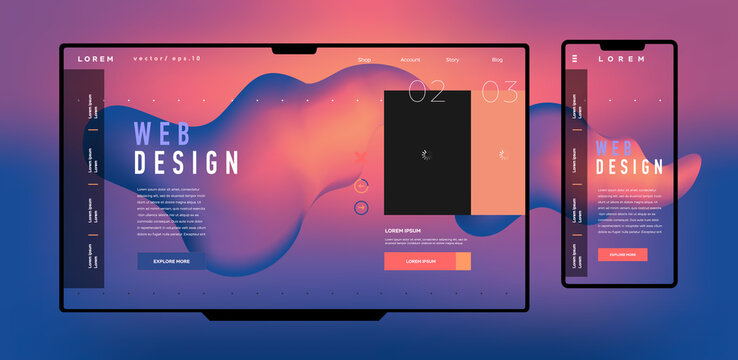Checking Out the Influence of Receptive Web Style on Ease Of Access and Customer Fulfillment Throughout Different Devices
The emergence of responsive internet layout (RWD) has actually changed the electronic landscape, specifically in boosting availability and individual satisfaction across a plethora of tools. By utilizing flexible interfaces and adaptable designs, RWD not just caters to varied user demands however also resolves the vital importance of inclusivity in internet experiences.

Meaning of Receptive Website Design
Responsive Website Design (RWD) transforms the user experience across different gadgets by making sure that internet content adapts fluidly to different display dimensions and positionings. This style method uses flexible grids, layouts, and photos, along with CSS media queries, to create a smooth surfing experience. By employing these techniques, RWD allows websites to instantly reorganize and resize content, making it accessible on devices ranging from computer to mobile phones.
The core concept of RWD is to provide an optimal viewing experience, that includes simple reading and navigation without the requirement for excessive resizing or scrolling. This adaptability is important in an electronic landscape where customers gain access to information through numerous tools with varying display resolutions. RWD not only enhances use however likewise enhances tons times, as it usually utilizes a single codebase to offer numerous gadgets, minimizing the requirement for different mobile sites.
Inevitably, Receptive Website design intends to create a engaging and cohesive user experience, ensuring that content is functionally reliable and visually appealing, no matter the tool being used. This versatility is critical in satisfying the varied demands of today's internet individuals, cultivating engagement and contentment across systems.
Significance of Accessibility
Just how can we guarantee that all customers, no matter of their capabilities, can engage with internet material effectively? Ease of access in website design is of critical value, as it cultivates inclusivity and ensures equal access to info for people with handicaps. This encompasses visual, acoustic, and cognitive problems, calling for developers to consider diverse customer requirements.
Implementing ease of access attributes, such as different text for photos, keyboard navigation, and proper shade comparison, allows customers to interact with content flawlessly. Furthermore, sticking to established guidelines, such as the Web Material Access Standards (WCAG), provides a structure for developing available web experiences. web design.
By focusing on access, companies not just abide with lawful requirements yet also boost their brand reputation, showing a commitment to social responsibility. Moreover, easily accessible internet sites usually lead to improved functionality for all users, as attributes developed for inclusivity can profit a wider target market.
Ultimately, the importance of accessibility goes beyond plain conformity; it is regarding producing a digital environment where every individual can navigate, comprehend, and involve with material properly, therefore improving the overall internet experience for every person.
Customer Satisfaction Throughout Instruments
Lots of individuals expect a smooth experience when accessing internet material throughout different devices, from desktop computers to smart devices. This expectation is rooted in the enhancing diversity of tools and screen sizes available today. Receptive website design (RWD) plays a crucial function in fulfilling these assumptions by guaranteeing that internet sites adapt fluidly to various display screen environments.
Individual satisfaction is dramatically influenced by the accessibility and functionality of an internet site - web design. When users can conveniently navigate, check out, and connect with content despite the tool they are using, their general satisfaction boosts. A well-implemented receptive layout decreases the need for zooming or horizontal scrolling, which can annoy users and lead to higher bounce prices
As individuals engage with content that is tailored to their device, they are much more likely to spend time on the site, return for future brows through, and recommend it to others. Eventually, receptive web design fosters a favorable connection between users and web content across gadgets.
Effect On Mobile Users

The effect of this page RWD on mobile users expands past aesthetic appeals; it dramatically affects use. A properly designed receptive site lowers this contact form the requirement for extreme scrolling and zooming, promoting an extra instinctive interaction. Additionally, it fosters inclusivity by accommodating customers with varying capacities, making sure that those who depend on smart phones can access details with simplicity.
Furthermore, mobile users gain from faster filling times, as RWD maximizes sources based on tool capacities. This efficiency is crucial, as mobile users often look for fast info and might abandon websites that stop working to pack promptly. Inevitably, the integration of responsive internet style is essential for satisfying the varied needs of mobile customers, enhancing their general experience and motivating continued interaction with the web content.
Best Practices for Application
Applying receptive website design (RWD) properly requires adherence to a number of ideal practices that make certain optimal performance throughout devices. Initially, making use of a fluid grid design is essential; this allows aspects to resize proportionally based upon the display measurements, providing a seamless experience. Additionally, utilizing adaptable photos ensures that visuals scale properly without shedding top quality or creating layout problems.

It is also vital to frequently examine the site throughout various platforms and gadgets to determine potential functionality concerns. Devices such as browser programmer devices and receptive layout screening services can aid in this procedure. Guaranteeing that all interactive components are touch-friendly and maximizing page load times considerably add to customer satisfaction and availability. By sticking to these best practices, organizations can create a robust and obtainable internet visibility that satisfies the diverse requirements of individuals across different gadgets.
Conclusion
In verdict, check responsive internet layout plays a critical role in improving accessibility and individual satisfaction throughout diverse gadgets. Ultimately, the assimilation of best methods in responsive layout fosters inclusivity, minimizes bounce rates, and advertises greater customer engagement.
The emergence of responsive web layout (RWD) has transformed the digital landscape, particularly in enhancing accessibility and customer contentment throughout a wide variety of gadgets.Responsive Internet Style (RWD) transforms the customer experience throughout numerous gadgets by making sure that web content adapts fluidly to different display dimensions and alignments. Eventually, receptive web layout promotes a positive relationship in between individuals and web content across devices.
Over 54% of global internet website traffic currently originates from mobile gadgets, highlighting the important importance of maximizing web experiences for this individual base. Responsive web layout (RWD) plays a crucial duty in boosting access and user complete satisfaction for mobile users.